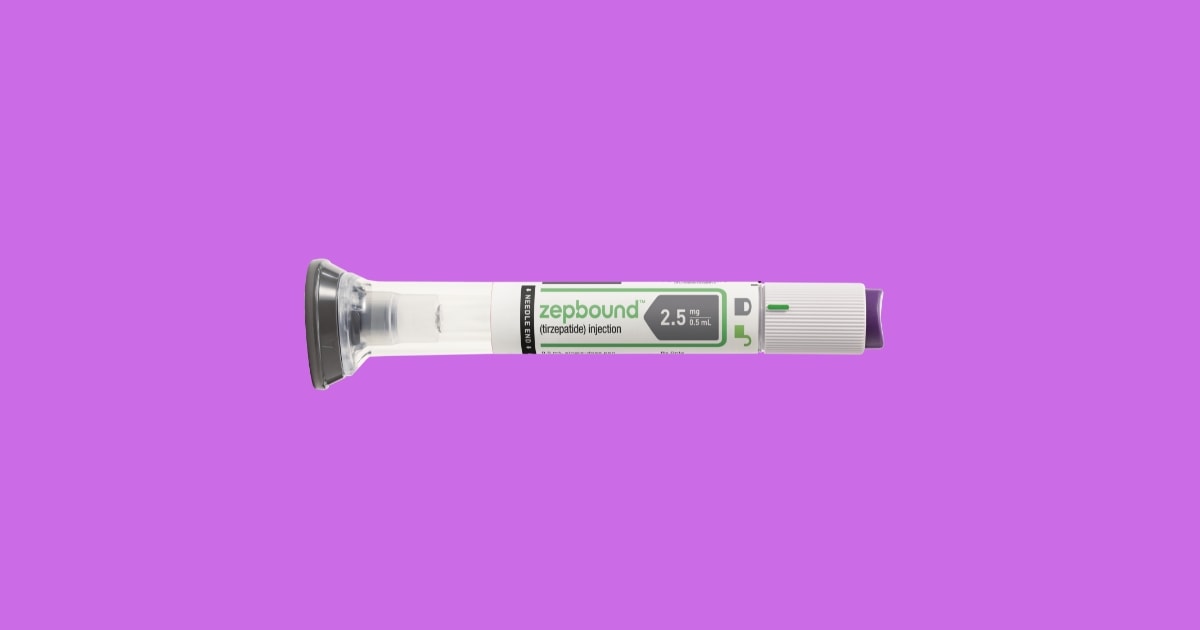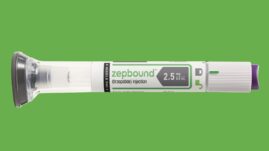Zepbound is a new medication used for weight loss and maintenance in people who are overweight or obese. It was approved by the U.S. Food and Drug Administration (FDA) in 2023.
It can be difficult to determine how much Zepbound is appropriate for you and how to dose this medication.
This article will tell you everything you need to know about taking and dosing Zepbound.

Table of Contents
- What is Zepbound?
- How does Zepbound work?
- What dose do you typically start with?
- What is a normal Zepbound dose?
- How and when can you increase your dose?
- What is the right dose for me?
- What is the right dose for weight loss?
- What happens if I stop taking Zepbound?
- Are there different Zepbound pens?
- What is the strongest Zepbound?
- What do I do if I forget to take my dose?
- What to do in case of Zepbound overdose
- How do I store Zepbound?
What is Zepbound?
Zepbound is a prescription-only, once-weekly injectable medication belonging to the dual glucose-dependent insulinotropic polypeptide (GIP) and glucagon-like peptide-1 (GLP-1) receptor agonist drug class. (GLP-1 receptors and GIP receptors are specific proteins on cells that receive messages to help control insulin release and blood glucose management.)
By activating these receptors, Zepbound mimics the action of natural hormones that regulate blood sugar levels and suppress appetite, contributing to chronic weight management.
Its active ingredient, tirzepatide, is also used in Mounjaro, a medication FDA-approved for the treatment of type 2 diabetes by improving insulin secretion and blood sugar regulation.
Learn more in: Everything You Need to Know About Mounjaro.
How does Zepbound work?
Zepbound works in a few different ways. The GLP-1 hormone helps to slow stomach emptying and increase feelings of fullness, contributing to reduced calorie consumption. It also improves insulin sensitivity and helps to lower levels of the hormone glucagon, which in turn reduces glucose production by the liver.
Similarly, the GIP hormone helps regulate blood sugar levels, which can also reduce food cravings and lower appetite.
In studies, it has been shown to help people lose weight and improve blood pressure, blood sugar, and cholesterol levels.
Read more in: Everything You Need to Know About Zepbound.
What dose do you typically start with?
If you’re new to Zepbound, your doctor will want to start you on a low dose.
This is because the medication may cause adverse side effects, including nausea, vomiting, diarrhea, constipation, and low blood sugar (particularly if you also take insulin or medicines that stimulate the release of insulin, like sulfonylureas).
Find out more about potential adverse effects in: Zepbound Side Effects.
These symptoms usually go away after a few weeks of taking Zepbound, but taking a lower dose when you begin treatment can help prevent them altogether.
According to the manufacturer, a typical starting dose is 2.5 mg, taken once per week.
If you’re tolerating the medicine well without adverse side effects, your doctor may increase your dose after the first four weeks — but not before.
What is a normal Zepbound dose?
The appropriate maintenance dose of Zepbound varies from one person to another, largely based on their response to the medication and how well they tolerate it.
Zepbound is available in several dosage strengths:
- 2.5 mg (the recommended starting dose)
- 5 mg
- 7.5 mg
- 10 mg
- 12.5 mg
- 15 mg
Each dose is administered once weekly, preferably on the same day and time each week, and can be taken with or without food.
The maintenance dose, which is the regular dose used after the starting period, generally ranges from 5 mg to 15 mg once per week.
The process of finding the right maintenance dose involves gradual dose increases from the starting dose, guided by tolerance of and response to the medicine, under the strict supervision of a healthcare provider.
How and when can you increase your dose?
Zepbound dosing is carefully adjusted over time, beginning with a starting dose of 2.5 mg once weekly.
Based on individual response and tolerability, and in consultation with their healthcare provider, users may increase their dose in 2.5 mg increments, with a minimum interval of four weeks at each dose level before any adjustments.
For many people, a maintenance dose of 5 mg weekly is effective. However, if further weight management is needed and the medication is well-tolerated, incremental increases to 7.5 mg, 10 mg, 12.5 mg, or ultimately up to the maximum of 15 mg once weekly may be considered, each after at least four weeks at the current dose.
It’s important to only consider dose increases if there are no significant negative side effects and the treatment outcomes are not yet achieved. Always consult with your healthcare provider before making any changes to your dosing regimen.
What is the right dose for me?
Determining the right dose of Zepbound involves a collaborative effort between you and your healthcare provider, taking into account your unique health history, goals, and lifestyle factors such as diet and activity level.
Dosing is tailored based on individual response and tolerability, with the goal of finding the most effective dose that minimizes potential side effects.
While higher doses may increase weight loss for some people, they can also increase the likelihood of side effects such as nausea, vomiting, diarrhea, and low blood sugar levels, particularly during the adjustment phase.
It’s important to approach any dose adjustments with caution, especially considering that higher doses do not guarantee better outcomes for every individual. The potential for improved weight loss and metabolic parameters like blood sugar control and A1c (a measure of glucose control over the previous 2 to 3 months) must be balanced against the risk of side effects.
Always stick to the dosing regimen prescribed by your healthcare provider, and never take more than the recommended dose of Zepbound. Any changes to your dose should only be made under medical supervision.
What is the right dose for weight loss?
There is no ideal dose for weight loss — weight loss has been documented at multiple levels of dosing, aside from the initial starting dose (which most people do not use as their maintenance dose).
In a pivotal study published in The New England Journal of Medicine in 2022 of more than 2,500 adults, weight loss was observed at the 5-mg, 10-mg, and 15-mg doses.
At week 72 of the study, on average, those taking 5 mg per week had lost 15 percent of their starting weight, those taking 10 mg per week had lost 19.5 percent of their weight, and those taking 15 mg per week had lost 20.9 percent of their weight.
In contrast, the placebo (inactive treatment) group at week 72 had only lost an average of 3.1 percent of their weight.
Learn more in: Can Zepbound Help You Lose Weight?
What happens if I stop taking Zepbound?
Do not stop taking any medications without the guidance of your doctor.
After stopping Zepbound, many people will regain lost weight and may experience higher blood sugar levels from increased insulin resistance and hunger.
If you wish to stop taking Zepbound, your doctor will likely taper your dose to lessen the side effects as the medication leaves your system.
Talk with your doctor if you are experiencing severe adverse side effects, Zepbound doesn’t fit into your lifestyle, or your health insurance doesn’t cover the medication and you wish to stop taking it.
Your doctor may be able to suggest a suitable alternative.
Are there different Zepbound pens?
Yes — Zepbound is available in six different single-dose pens. This can help reduce the risk of dosing errors.
The pens are available in the following strengths:
- 2.5 mg
- 5 mg
- 7.5 mg
- 10 mg
- 12.5 mg
- 15 mg
If you need to increase your dose, you will need a new prescription from your doctor.
What is the strongest Zepbound?
All of the Zepbond pens contain the same active ingredient — tirzepatide. The larger dosing pens do not have a more potent drug formulation.
Rather, when people increase their dose of Zepbound, they simply increase the amount they take per week.
The maximum dose is 15 mg taken once per week.
What do I do if I forget to take my dose?
Remember to take your Zepbound dose on the same day each week, at generally the same time (for example, before breakfast or dinner).
If you miss a dose of Zepbound, take it as soon as possible within four days (96 hours) of your missed dose.
If you miss a dose for more than four days, skip that week and continue taking your Zepbound on your regular schedule the following week.
Do not take two Zepbound doses within three days of each other.
Missing one dose will not make you gain weight.
What to do in case of Zepbound overdose
Never take more Zepbound than you are prescribed.
If you overdose on Zepbound or take two doses of Zepbound within the same week, you may experience severe side effects, including nausea, vomiting, and low blood sugar, which can be life-threatening (especially if you’re also on insulin.)
Monitor for signs and symptoms of extremely low blood sugar, which include:
- Dizziness
- Confusion
- Increased heart rate
- Shallow breathing
- Shakiness
- Grogginess
- Fatigue
- Unconsciousness
Seek emergency medical attention immediately if you suspect you’ve overdosed on Zepbound.
How do I store Zepbound?
Store Zepbound at a temperature between 36 and 46 degrees Fahrenheit (2 and 8 degrees Celsius).
Ensure that Zepbound gets no hotter than 86 degrees Fahrenheit (30 degrees Celsius).
Never freeze your pens.
Zepbound can be left unrefrigerated for up to 21 days if the temperature never exceeds 86 degrees Fahrenheit (30 degrees Celsius). Do not refrigerate your pens if you’ve been keeping them at room temperature.
Keep your Zepbound pens in their original packaging to protect them from light and ensure their integrity. Always store medications out of reach of children to ensure safety.
Suggested next article: Everything You Need to Know About Zepbound.





Libby
I do not have drug prescription coverage at all for 2024.
I’m on Medicaid. MEDICAID DOES NOT COVER MY DRUGS.
Why can I get a savings card?